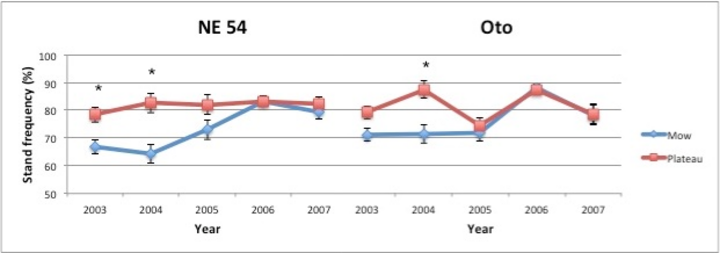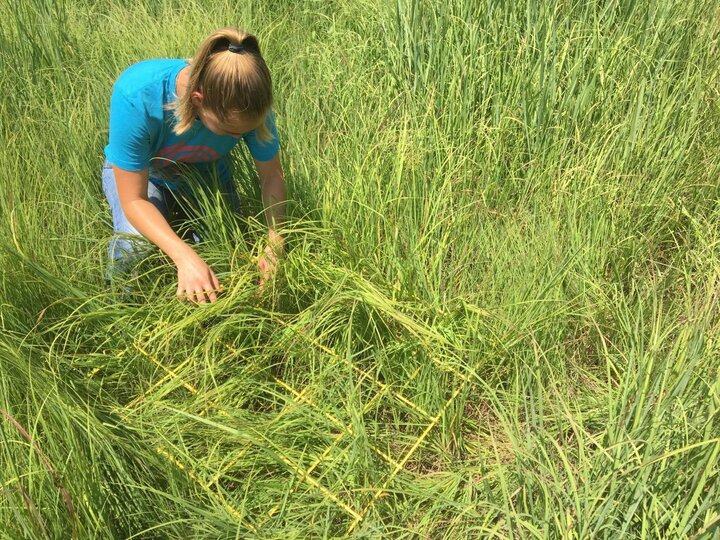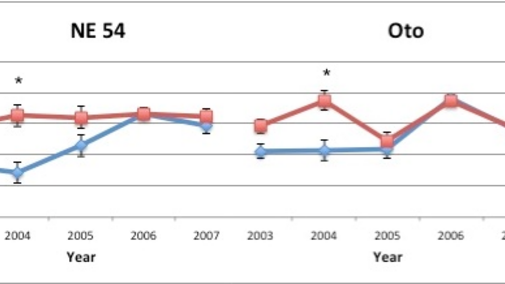Alexa Johnson, Student at the University of Nebraska-Lincoln and 2017 UNL Integrated Agronomic Systems Intern
Rob Mitchell, Research Agronomist, USDA-ARS Wheat, Sorghum, and Forage Research Unit
Daren Redfearn, Nebraska Extension Forage Crop Residue Specialist
Marty Schmer, Research Agronomist, USDA-ARS Agroecosystems Management Research Unit
Hillary Booher, Research Fellow, Purdue University



Herbicides and mowing are the two common weed control methods used for establishing perennial, warm-season grasses, such as indiangrass [Sorghastrum nutans (L.) Nash]. Historically, use of indiangrass has been limited by lack of seedling tolerance to atrazine and diuron, the only labeled herbicides for indiangrass. However, the development of newer herbicides, such as Plateau, have provided additional options for establishment. Plateau is one of the few herbicides labeled for broadleaf weed control during and after establishment of indiangrass. Weed competition during establishment of perennial warm-season grasses can reduce early seedling growth and forage yield by 33%.
This study evaluated two weed control methods and seeding rates on establishment and persistence of two indiangrass cultivars, ‘Oto’ and ‘NE 54’, from 2003 to 2007. Cultivars were seeded on May 15 at 100, 200, 300, 400, or 500 pure live seed (PLS) per square meter. These five seeding rates correspond to 10, 20, 30, 40, and 50 PLS per square foot. Either mowing or Plateau was included as a method of weed control. Plateau was applied at four ounces per acre as a pre-emergent weed control and mowing was to a six-inch stubble height as needed during the growing season. In the spring of the second growing season and in each of the subsequent growing seasons, plots were fertilized with 100 lbs of nitrogen per acre. Stand frequency was determined using a 30-inch by 30-inch frequency grid. At the end of the growing season, biomass was harvested to determine yield.
Stand frequency increased with increasing seeding rates for both cultivars, although Oto was more variable across the years than NE 54 (Figure 1). During early establishment (2003 and 2004), stand frequency was the lowest for the 10 PLS ft2 seeding rate for both of the cultivars (Figure 1). At the end of the study, the 10 PLS ft2 was the only seeding rate with less than 75% stand frequency (Figure 1). With the exception of the first year for Oto, stand frequency was greater under the herbicide treatment during early stand establishment, however, stand frequency was similar for both weed control treatments after the second year of the study (Figure 2).
Stand frequency was 20% greater using herbicide during the first two to three years of establishment. Also, dry matter (DM) yield was lower with mowing for both cultivars in 2004 and 2005 (Figure 3). At the conclusion of the study in 2006, DM yields were similar for both mowing and herbicide application.
With Plateau application, seeding rates as low as 20 PLS ft2 resulted in functional, persistent indiangrass stands with greater stand frequency than mowing in the first years of establishment. All seeding rates, except for the 10 PLS ft2 seeding rate, had greater than 75% stand frequency. After five years there were no differences in persistence regardless of weed control method. This research could potentially increase interest in establishing indiangrass for uses such as pasture, bioenergy, and conservation.

About the Author
Alexa Johnson is one of seven undergraduate students completing an Integrated Agronomic Systems Fellowship at the University of Nebraska-Lincoln in summer 2017.
She is continuing her studies at the University of Nebraska, where she is working toward a bachelor's degree with a major in grazing livestock systems and a minor in animal science.
Support
Support for this project was provided by the USDA NIFA Agriculture and Food Research Initiative: Education and Literacy Initiative–Undergraduate Experiential Learning Fellowship Program and the University of Nebraska-Lincoln Department of Agronomy and Horticulture.

